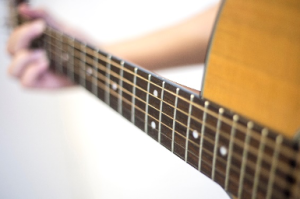23.2 Present Tense of -ся Verbs (Second Conjugation)

In this module, you will learn present-tense forms of six common –ся verbs that belong to the second conjugation.
Завда́ння 1
Read the dialogue below and mark all forms of the verb “to study/learn.” Then answer the questions that follow.

Важли́во!
Some -ся verbs, like the verb вчи́тися, belong to the second conjugation. Their patterns of present-tense endings are identical to those of other second-conjugation verbs—only these endings precede the -ся. For example, the present-tense endings of the verb вчи́тися are the same as those in the лежа́ти type:
| лежа́ти | вчи́тися | |
|---|---|---|
| я | лежу́ | вчу́ся |
| ти | лежи́ш | вчи́шся |
| він/вона/воно | лежи́ть | вчи́ться |
| ми | лежимо́ | вчимо́ся |
| ви | лежите́ | вчите́ся |
| вони | лежа́ть | вча́ться |
Another common -ся verb that belongs to this type is ба́читися (to see each other).
Завда́ння 2
Listen to the audio below and choose the most appropriate responses to the questions you hear.
Transcript – Завдання 2
- Де вона вчиться?
- Ти часто бачишся з Оленкою?
- Ваші діти вчаться в університеті?
- Чому ви так рідко бачитеся з батьками?
- Ви вчитеся кататися на лижах?!
- Чому ми так рідко бачимося?!
Цікаво!
In previous modules, you have seen two other verbs that are similar in meaning to вчи́тися: вивча́ти (see Module 21.1) and навча́тися (see Module 23.1). While all three verbs can mean “to study,” they are used somewhat differently.Вивча́ти is used only with subjects or majors, which are expressed by means of nouns:
Я вивча́ю літерату́ру (бі́знес, пра́во…).
Only вчи́тися can be used with the infinitives of verbs to denote learning a skill:
Я вчу́ся гра́ти в ша́хи (ката́тися на велосипе́ді, писа́ти францу́зькою…).
Both вчи́тися and навча́тися can be used to state where or in what year/grade one studies, but in this context навча́тися is quite formal and вчи́тися is informal:
В університе́ті навча́ються студе́нти з Кана́ди, Євро́пи, Кита́ю та Австра́лії.
Всі мої́ дру́зі вча́ться в університе́ті.
Завда́ння 3
Read the dialogues below and fill in the blanks with the most appropriate verb forms from the bank.
Завда́ння 4
Read the dialogues below and note the present-tense forms of the -ся verbs. Then answer the questions that follow.

– Що ти ди́вишся?
– Дивлю́ся одну́ коме́дію.
– Ціка́ва?
– Та не ду́же, але́ брати́ ди́вляться футбо́л, а це зо́всім неціка́во.
– Я тако́ж не люблю́ диви́тися футбо́л… Але ми з Андрі́єм ча́сто ди́вимося те́ніс.

– О, яка́ га́рна фотогра́фія! Це На́стя? А хто фото́граф?
– Я. Я вже давно́ ціка́влюся фотогра́фією…
– Ти ціка́вишся фотогра́фією?! Зна́єш, мій до́брий друг тако́ж ціка́виться не́ю і фотографу́є все, що ба́чить!
– Ну, за́раз всі ціка́вляться фотогра́фією, бо всі ма́ють інстагра́м і ро́блять для ньо́го бага́то фо́то.
– Це пра́вда. Я сама́ (myself) почина́ю ціка́витися фотогра́фією…
Важли́во!
As in the verbs of the люби́ти type, the verbs диви́тися and ціка́витися in the present tense undergo a consonant mutation in two forms – the first person singular and the third person plural.
Compare:
| люби́ти | диви́тися | |
|---|---|---|
| я | люблю́ | дивлю́ся |
| ти | лю́биш | ди́вишся |
| він/вона/воно | лю́бить | ди́виться |
| ми | лю́бимо | ди́вимося |
| ви | лю́бите | ди́витеся |
| вони | лю́блять | ди́вляться |
Знайо́митися (to get acquainted) is another common -ся verb that adds -л- to its stem in the first person singular and the third person plural:
Я ча́сто знайо́млюся з ціка́вими людьми́ в інтерне́ті.
Завда́ння 5
Choose the most appropriate question to which each statement you hear could be a logical response.
Transcript – Завдання 5
- Я не цікавлюся політикою.
- Ти знаєш, мої батьки рідко дивляться телевізор.
- Знайомляться з нашими новими сусідами.
- Дивлюся новини.
- Вчаться в школі, цікавляться комп’ютерами.
- Я ніколи не знайомлюся з хлопцями в інтернеті.
Завда́ння 6
Read the sentences below and fill in the blanks with the most appropriate verb forms from the bank.
Завда́ння 7
Read the dialogue and mark all forms of the verb “to be afraid.” Then answer the questions below.

Select the best response:
Важли́во!
The verb боя́тися belongs to the стоя́ти type, which is a less common type in the second conjugation:
| стоя́ти | боя́тися | |
|---|---|---|
| я | стою́ | бою́ся |
| ти | стої́ш | бої́шся |
| він/вона/воно | стої́ть | бої́ться |
| ми | стоїмо́ | боїмо́ся |
| ви | стоїте́ | боїте́ся |
| вони | стоя́ть | боя́ться |
As the dialogue above illustrates, the verb боя́тися is also unusual in that it requires its object to be in the genitive case:
Я бою́ся війни́ і тро́хи бою́ся екза́менів.
Завда́ння 8
You will hear six questions. Complete the response to each by providing the correct present-tense form of the -ся verb that you hear. Then answer the questions that follow.
Transcript – Завдання 8
- Я трохи боюся літати… А ти?
- Ти знаєш, що лікарі не рекомендують дітям багато дивитися телевізор?
- Де ти вчишся?
- Чому твої батьки не плавають? Вони бояться води?
- Ти цікавишся гімнастикою?
- Ви часто бачитеся з Ярославом?
Мо́вний пазл
Look through the activities you have just completed and choose the correct statements to summarize what you have learned.
А тепе́р тест!
Complete the dialogue below using the appropriate present tense forms of the verbs in the bank. You should only use each verb once.

